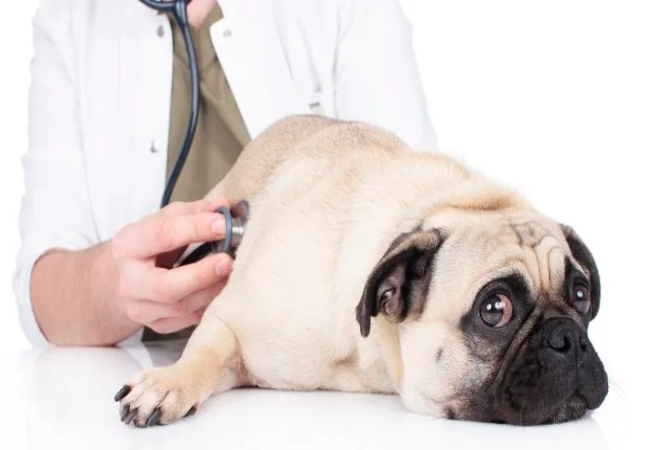Digoxin Toxicity in Dogs: 2025 Vet Guide 🩺🐶

In this article
Digoxin Toxicity in Dogs: 2025 Vet Guide 🩺🐶
By Dr. Duncan Houston BVSc
Hello! I’m Dr Duncan Houston, BVSc, veterinarian and founder of Ask A Vet. This thorough 2025 guide unpacks digoxin toxicity in dogs—from how it works, to the telltale signs on ECG, GI and cardiac symptoms, diagnosis, treatments, and how telehealth tools revolutionize monitoring and care.
1. 🧬 What Is Digoxin?
Digoxin is a cardiac glycoside that increases heart contractility and reduces AV nodal conduction by inhibiting Na⁺/K⁺‑K-ATPase—used to treat arrhythmias like atrial fibrillation.
However, therapeutic and toxic doses overlap in dogs, especially those with renal or electrolyte imbalances.
2. ⚠️ Why Toxicity Happens
-
- Overdose: Acute ingestion or IV dosing ≧ of 0.177 mg/kg can cause toxicity.
- Chronic risks: Reduced renal clearance, low potassium, dehydration, drug interactions.
- P-gp mutations: MDR1 variants can raise risk—consider testing prior to use.
3. 🧩 How Digoxin Affects the Body
-
- Increases automaticity → ectopic beats and tachyarrhythmias.
- Increases vagal tone → slowed AV nodal conduction and bradyarrhythmias.
- Electrolyte shifts: potassium imbalance worsens toxicity.
4. 📋 Symptoms to Spot
-
- GI signs: vomiting, anorexia, diarrhea, abdominal pain.
- Cardiac: weakness, collapse, syncope from arrhythmias.
- Neurologic: lethargy, confusion, seizures (severe cases).
- Ocular (rare): blurred vision, color changes.
- Renal: Worsened kidney function may complicate toxicity.
5. 🩺 ECG & Lab Clues
-
- Digoxin effect (therapeutic): scooped (“Salvador Dalí”) ST segments, T‑wave flattening, QT shortening, prolonged PR.
-
Toxic ECG:
- Premature beats (PVCs/PACs), bigeminy.
- Tachy-arrhythmias: atrial tachycardia, junctional tachycardia, slow AFib.
- Brady-arrhythmias: sinus bradycardia, any degree of AV block.
- Bidirectional VT—pathognomonic but rare.
- Labs: elevated digoxin level, hyperkalemia, renal markers.
6. 🔬 Diagnosis Steps (2025)
-
- History/exam: exposure, dosing, kidney symptoms.
- ECG & continuous monitoring: use HOLTER or wearable tech for arrhythmia detection.
- Labs: digoxin concentration 6–8 hr post-dose, electrolytes, renal function every 7–14 days at start; then q3–4 mos.
- Rule out other poisons/drugs.
- Genetic testing: MDR1 screening pre-treatment.
- Tele-triage: owners upload ECG/lab info to Ask A Vet for instant evaluation and dosing advice.
7. 🛠 Treatment Protocols
a. Acute Management
-
- Stabilization: hospitalization, IV fluids, oxygen.
- Gastric decontamination: activated charcoal within 1–2 hrs.
- Correct electrolytes: IV potassium for hypokalemia.
- Antidote: digoxin-specific Fab fragments (Digibind) for life-threatening arrhythmias.
- Symptomatic arrhythmia treatment: atropine for bradycardia; lidocaine/procainamide for VT if Fab unavailable.
b. Long-Term Support
-
- Reduce/stop digoxin: restart at a lower dose only when levels are normalized and ECG stable.
- Monitor serum levels: every 3–4 months during therapy.
- Holter/watch ECG: remote uploads via wearable tech to catch silent arrhythmias.
- Telehealth dose management: adjustments via virtual consults with cardiologists.
- Owner education: monitor appetite, vomit frequency, breathing, and fainting.
8. 🏥 Prognosis
-
- Good if treated early, toxins reversed, electrolytes corrected.
- Guarded in chronic or severe cases—renal dysfunction or ongoing arrhythmias worsen the outlook.
- Unresponsive VT or persistent blocks may require permanent pacemaker.
9. 🌐 2025 Telehealth & Tech
-
- Wearable ECG devices: Detect digoxin-toxic arrhythmias early.
- AI ECG interpretation: flag patterns like bidirectional VT, ST scooping.
- Remote Fab dosing guidance: virtual consults direct effective use.
- Medication reminders & labs: tracked via pet-medication apps.
- Owner alerts: real-time notifications on arrhythmias, vitals, and intake changes.
10. 🏠 At-Home Tips
-
- Log food and vomiting.
- Check gum color, pulse, and breathing.
- Upload ECG rhythms if feeling faint or irregular heartbeat.
- Attend scheduled lab draws and virtual check-ins.
- Keep emergency contact handy for Poison Control or Ask A Vet service.
11. 🐕 Who's Most at Risk?
-
- Dogs on digoxin with poor renal function.
- Hypokalemic dogs—on diuretics or with GI losses.
- MDR1 mutant breeds—Collies, Shepherds, etc.
- Dogs receiving multiple cardiac medications.
12. 💬 FAQs for Pet Owners
- How soon do signs appear?
- Acute overdose: within hours. Chronic toxicity may take days to weeks.
- Can low digoxin levels still cause harm?
- Yes—effects can still occur if tolerances vary or concurrent illness is present.
- Is the antidote safe for dogs?
- Yes, Fab fragments are highly effective but costly, reserved for serious arrhythmias.
- Should I stop digoxin if my dog vomits?
- Don’t stop abruptly—consult your vet to adjust the dose and check levels.
13. ❤️ How Ask A Vet Supports You
-
- 24/7 ECG Holter uploads and expert interpretation.
- Real-time alerts for dangerous arrhythmias.
- Teleconsults to manage digoxin dosing and toxicity.
- Prescription refill and lab scheduling alerts.
- Connection with local emergency care when needed.
Download the Ask A Vet app to integrate your dog’s heart medication safely—home-based pro care. 🐾❤️
14. 🔚 Final Takeaway
Digoxin can be a lifesaver—but it has a narrow safety window. Recognizing early signs, monitoring ECGs, lab tracking, and rapid intervention with antidotes are essential in 2025. Wearable tech and telehealth tools make it easier than ever to titrate dosing and prevent toxicity. With early recognition, treatment, and partnership between you, Ask A Vet, and your vet, your dog can safely benefit from digoxin therapy while minimizing risk.
— Dr Duncan Houston, BVSc






